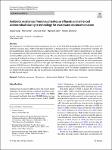Thông tin tài liệu
Thông tin siêu dữ liệu biểu ghi
| Trường DC | Giá trị | Ngôn ngữ |
|---|---|---|
| dc.contributor.author | Cong, Xiaoyu | - |
| dc.contributor.author | Krolla, Peter | - |
| dc.contributor.author | Khan, Umer Zeb | - |
| dc.date.accessioned | 2023-10-02T08:04:04Z | - |
| dc.date.available | 2023-10-02T08:04:04Z | - |
| dc.date.issued | 2023 | - |
| dc.identifier.uri | https://link.springer.com/article/10.1007/s11356-023-29972-x | - |
| dc.identifier.uri | https://dlib.phenikaa-uni.edu.vn/handle/PNK/9396 | - |
| dc.description | CC-BY | vi |
| dc.description.abstract | The frequencies of 6 different facultative pathogenic bacteria of the ESKAPE group (priority list WHO) and a total of 14 antibiotic resistance genes (ARGs) with different priorities for human medicine were quantified in wastewaters of poultry and pig slaughterhouses using molecular biological approaches. Raw sewage from poultry and pig slaughterhouses was found to be contaminated not only with facultative pathogenic bacteria but also with various categories of clinically relevant ARGs, including ARGs against the reserve antibiotics group. The concentration of the different gene targets decreased after on-site conventional biological or advanced oxidative wastewater treatments, but was not eliminated. Hence, the antimicrobial BlueLight (aBL) in combination with a porphyrin photo-sensitizer was studied with ESKAPE bacteria and real slaughterhouse wastewaters. | vi |
| dc.language.iso | en | vi |
| dc.publisher | Springer | vi |
| dc.subject | ARGs | vi |
| dc.subject | aBL | vi |
| dc.title | Antibiotic resistances from slaughterhouse effluents and enhanced antimicrobial blue light technology for wastewater decontamionation | vi |
| dc.type | Book | vi |
| Bộ sưu tập | ||
| OER - Khoa học môi trường | ||
Danh sách tệp tin đính kèm:

